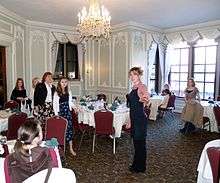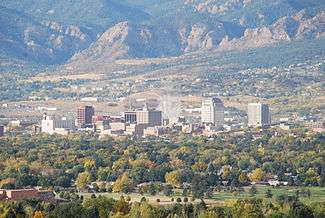Glen Eyrie
|
Glen Eyrie | |
 | |
| Location | Colorado Springs, Colorado |
|---|---|
| Coordinates | 38°53′30″N 104°53′04″W / 38.89167°N 104.88444°WCoordinates: 38°53′30″N 104°53′04″W / 38.89167°N 104.88444°W |
| Built | 1871 |
| Architect | Frederick Sterner |
| Architectural style | Tudor Revival |
| NRHP reference # |
75000519 [1] (original) 16000866 (increase) |
| Significant dates | |
| Added to NRHP | April 21, 1975 |
| Boundary increase | December 20, 2016 |
Glen Eyrie is an English Tudor-style castle built in 1871 by General William Jackson Palmer, the founder of Colorado Springs. There are 17 guest rooms (12 Deluxe guest rooms and 5 premier guest rooms) in the castle, as well as 7 meeting rooms to include the Castle Great Hall (2200 square feet room in the castle that can hold up to 240 people) and 2 dining rooms in the castle (The Castle King James Hall has seating for 180 people and the Castle Music & Library rooms for seating for up to 58 people). This house was his and his wife's dream home and is near Colorado Springs in the northwest foothills just north of the Garden of the Gods rock formations (now a city park). After building a large carriage house, where the family lived for a time, Palmer and his wife Mary (Queen) Mellen built a 22-room frame house on the 800-acre (3.2 km2) estate. This house was remodeled in 1881 to include a tower and additional rooms, and made to resemble a stone castle in 1903, reminiscent of those native to England.
Queen Palmer, at age 21, opened the first public school in Colorado Springs in November 1871. The Palmers had three daughters, Elsie, Dorothy, and Marjory.
In 1880, Mrs. Palmer suffered a mild heart attack and was advised to move to a lower altitude. She and the girls moved to the East Coast and then to England where General Palmer visited them as often as he could. Queen died on December 28, 1894, at the age of 44. In sorrow, General Palmer went to England to return Mrs. Palmer's remains and the girls to Colorado Springs. They at this time decided to tear down their home and in memory of his wife because she so enjoyed the feel of a castle home they re-built the 33,000 square foot castle for her.
Glen Eyrie's use today
Glen Eyrie is an English Tudor-style castle built by General William Jackson Palmer, the founder of Colorado Springs. There are 17 guest rooms in the castle, as well as 4 meeting rooms, 2 dining rooms, and 24 fireplaces. The castle has several features that were advanced for its time, including a primitive intercom system and a chimney system that would hold the smoke until the wind was blowing in the right direction to take the smoke out of the valley. Glen Eyrie is on the National Register of Historic Places.

The castle is now owned by The Navigators. It is open for public tours and events, and can be rented for private programs.
Events hosted at the castle include English and Victorian teas[2] throughout the week and Christmas Madrigal Banquets[3] beginning after Thanksgiving. Glen Eyrie also puts on marriage getaways, men retreats, women retreats, family conferences, and much more. To check up on their upcoming programs and different retreats you will need to visit their website.
Glen Eyrie's location at the base of Queen's Canyon leaves it vulnerable to flash floods, a risk that increased after the 2012 Waldo Canyon Fire. The fire did no damage to the Glen Eyrie grounds, but it stripped the vegetation from Queen's Canyon. Over a million dollars in flood mitigation has since provided two debris nets and a wider, deeper, concrete and cinder block reinforced creek bed, which allows water to flow at 2,000 cubic feet per second through the grounds at Glen Eyrie.[4]
See also
References
- ↑ National Park Service (2006-03-15). "National Register Information System". National Register of Historic Places. National Park Service.
- ↑ Navigators: English and Victorian teas
- ↑ Navigators: Christmas Madrigal Banquets
- ↑ "Fire scars lead to mitigation work - The Colorado Springs Business Journal". April 19, 2013. Retrieved July 21, 2018.
External links
| Wikimedia Commons has media related to Glen Eyrie. |
